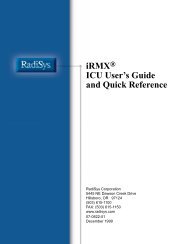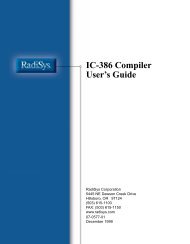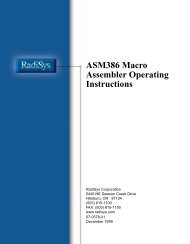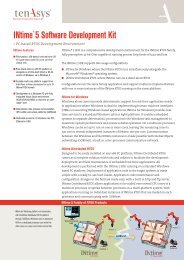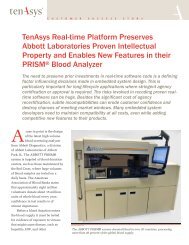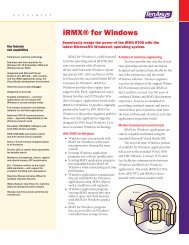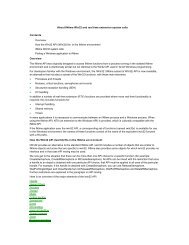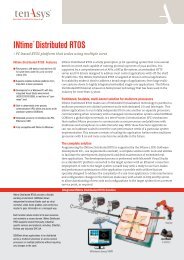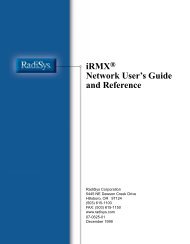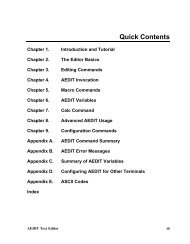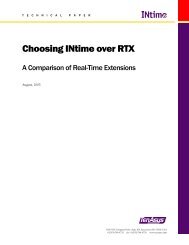INtime® 3.1 Software - tenAsys
INtime® 3.1 Software - tenAsys
INtime® 3.1 Software - tenAsys
Create successful ePaper yourself
Turn your PDF publications into a flip-book with our unique Google optimized e-Paper software.
INtime <strong>3.1</strong> <strong>Software</strong><br />
Interrupt processing<br />
Interrupts are signals from devices such as a malfunctioning robot or interactive<br />
terminal. You connect interrupt sources to the processor through the PC’s two PICs<br />
(Programmable Interrupt Controllers).<br />
With interrupt processing, your application can handle interrupts occurring at random<br />
times (asynchronously) and can handle multiple interrupts without losing track of the<br />
running thread, or those threads waiting to run. Interrupts can occur while the<br />
processor is executing either an unrelated thread or a related thread, as shown in the<br />
next figure.<br />
Figure 4-3. Interrupt handler interrupting a thread<br />
Event<br />
PIC<br />
Processor<br />
Thread A<br />
Thread B<br />
IRQ signal<br />
IRQ handler<br />
<br />
Thread B, the running thread, repositions the robotic arm.<br />
The robotic arm malfunctions and sends an interrupt signal through the PIC.<br />
As soon as it receives the signal, the microprocessor stops the running thread and starts an<br />
interrupt handler. The interrupt handler runs in the context of thread B. No new thread is loaded;<br />
thread B’s state does not need to be saved. It remains loaded in RAM until the scheduler runs it<br />
again. Thread A, the print thread, is still waiting to run.<br />
Typically, numerous sources of interrupts exist in an application. Some of them, like<br />
the malfunctioning robotic arm, are critical; some of them are not. You assign interrupt<br />
levels (which map directly to priorities) to the interrupt sources by the order in which<br />
you connect your external sources to the PIC. INtime software handles more critical<br />
interrupts first, and keeps track of which interrupts occurred, the order in which they<br />
occurred, and which ones have not been handled.<br />
Interrupt handlers can perform very limited operations, so you typically write an<br />
interrupt handler to signal an interrupt thread. The interrupt thread's priority can be<br />
automatically assigned, based on the interrupt level of the external source.<br />
Multithreading and interrupt processing simplify expanding an application. Because of<br />
the one-to-one relationship between interrupts and threads, you add a new thread<br />
42



